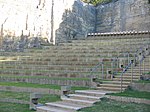The Japanese School in Perth

The Japanese School in Perth (パース日本人学校, Pāsu Nihonjin Gakkō), abbreviated to JSP, is a Japanese international school located in City Beach within the Town of Cambridge of Perth, the capital city of Western Australia. The school opened in 1978. Historically the school was located on the property of a local Australian school, and the two schools had joint activities. Since 1998 the school uses the four term system used by Australian schools. The school was previously in Scarborough. In its history, up to 2012, the school had moved three times. After Education Minister Peter Collier announced that the school will relocate from its Kalinda Drive location in City Beach, it co-located with City Beach Primary School at Marapana Road in City Beach.
Excerpt from the Wikipedia article The Japanese School in Perth (License: CC BY-SA 3.0, Authors, Images).The Japanese School in Perth
Marapana Road, Town of Cambridge
Geographical coordinates (GPS) Address Phone number Website Nearby Places Show on map
Geographical coordinates (GPS)
| Latitude | Longitude |
|---|---|
| N -31.935886 ° | E 115.765118 ° |
Address
City Beach Primary School
Marapana Road 30
6015 Town of Cambridge, City Beach
Western Australia, Australia
Open on Google Maps







